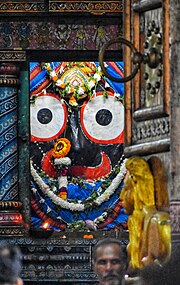You can help expand this article with text translated from the corresponding article in French. (May 2022) Click for important translation instructions.
|

Mahari is a ritualistic dance forms form the eastern Indian state of Odisha that used to be performed at the temple of Lord Jagannatha at Puri by devadasi dancers called mahari. Following the abolition of the devadasi system, the dance has been discontinued at the Jagannatha Temple but is now performed on stage at many venues. The Mahari dance spurred the development of both Odissi and the Gotipua dance forms of Odisha. The Maharis have been among the foremost exponents of both traditional Odia dance and Odissi music.
History
Mahari dance is nearly thousand years old with dance having been an integral part of the daily rituals at the Jagannath temple of Puri since the time of Ganga rulers of Utkala. In the twelfth century, Chodaganga Deva gave the dance a legal status, establishing new localities for the maharis to stay and introduced new ceremonies for the deity. The classical dance form of Odissi has its roots in the Mahari dance while the Gotipua dance originated as an offshoot of the Mahari tradition when it went into decline in the fifteenth and sixteenth centuries. The Gotipua and the Mahari dances were patronized by Ramachandra, the Raja of Khurda and it is from his time that the devadasis who until then were attached only to temples came to be patronized by royal courts. With the abolition of the devadasi system in independent India, Mahari dance entered a period of steady decline. Its revival and adaptation for stage performances are credited to the late Odissi doyen Guru Pankaj Charan Das. The Odissi dancer Rupashri Mohapatra, a disciple of Pankaj Das, has also played a notable role in reviving Mahari. The dance was once taught exclusively to the maharis of the Jagannath Temple. The last of the professional maharis was Sashimani Devi.
Maharis
| Oṛiśī Sangīta |
| Odissi music |
|---|
 Mahāprabhu Jagannātha Mahāprabhu Jagannātha |
| Composers |
| Shāstras |
| Compositions |
| Instruments |
Maharis were the temple dancers or devadasis of the Jagannath Temple at Puri and the dance takes its name after them. According to legend, Lord Jagannath enjoys a mahari dance recital before retiring to bed at night and the dancers performed the dance for his satisfaction. The maharis were given grants of land for their sustenance and they in turn behaved as the deity's spouse, singing and dancing the Gita Govinda of Jayadeva to please him. The Gita Govinda is ritually sung according to traditional ragas & talas of Odissi music, the traditional classical music of the state of Odisha. The deity himself used to be dressed up in specially woven saris containing verses from the Govinda weaved into them and the mahari, dressed in special jewelry and decked with flowers, performed exclusively for the deity. The term mahari stands for maha-nari meaning 'great lady'. The Maharis performed exclusively for the deity in the sanctum sanctorum as part of the daily rituals at the temple and occasionally at temple processions. In earlier times the maharis enjoyed a place of esteem in society and girls from elite families took it up as a respectable profession. The Maharis belonged to six groups namely Bhitara Gauni, Bahara Gauni, Nachuani, Patuari, Raj Angila, Gahana Mahari and Rudra Ganika. Since the abolition of the devadasi system, the dance has been discontinued at the Jagannath Temple.
Mahari Award
The Mahari Award is an award instituted by Guru Pankaj Charan Odissi Research Foundation. In 2012, it was awarded to the Odissi dancer Minati Pradhan.
References
- ^ "An effort to popularise Mahari dance tradition". September 25, 2012.
- ^ "Giving the young a chance". The Hindu. June 8, 2007. Archived from the original on August 5, 2011. Retrieved 7 February 2013.
- ^ "A SYSTEMATIC ANALYSIS OF ODISSI DANCE". Narthaki. Retrieved 7 February 2013.
- "Seminar on Mahari dance". The Hindu. May 23, 2011. Archived from the original on May 28, 2011. Retrieved 7 February 2013.
- "Spellbinding act". The Hindu. September 10, 2010. Retrieved 7 February 2013.
- "Devadasi fest delights audience". The Hindu. October 24, 2008. Archived from the original on October 28, 2008. Retrieved 7 February 2013.
- "Dancers pay tribute to guru". The Telegraph. September 6, 2011. Archived from the original on September 24, 2015. Retrieved 7 February 2013.
- "Sashimani Devi, Last of India's Jagannath Temple Dancers, Dies at 92". New York Times. March 23, 2015. Retrieved 2015-03-23.
Sashimani Devi, the last ritual dancer at the Jagannath Temple in eastern India, died on Thursday in the city of Puri, bringing an end to a centuries-old tradition that was condemned as exploitative by social reformers, Victorian missionaries and the leaders of independent India. She was 92. ...
- "Why deny the Lord - Reintroduce temple dance ritual and spread it to other shrines". The Telegraph. May 9, 2011. Archived from the original on March 4, 2016. Retrieved 7 February 2013.
- "Danseuse steps in to revive Mahari". The Telegraph. May 19, 2011. Archived from the original on March 4, 2016. Retrieved 7 February 2013.
- "Of dancers wedded to the Lord". The Hindu. November 14, 2012. Retrieved 7 February 2013.
- "Mahari award to be presented to Minati Pradhan". The Hindu. March 11, 2012. Retrieved 7 February 2013.
External links
 Media related to Mahari dance at Wikimedia Commons
Media related to Mahari dance at Wikimedia Commons
| Culture of Odisha | |||||||
|---|---|---|---|---|---|---|---|
| Dance |
| ||||||
| Music | |||||||
| Play, theatre and puppetry |
| ||||||
| Wedding | |||||||
| Festivals | |||||||
| Martial arts | |||||||
| Handlooms | |||||||
| Arts and Handicrafts |
| ||||||
| Architecture | |||||||
| Calendar (Panjika) | |||||||